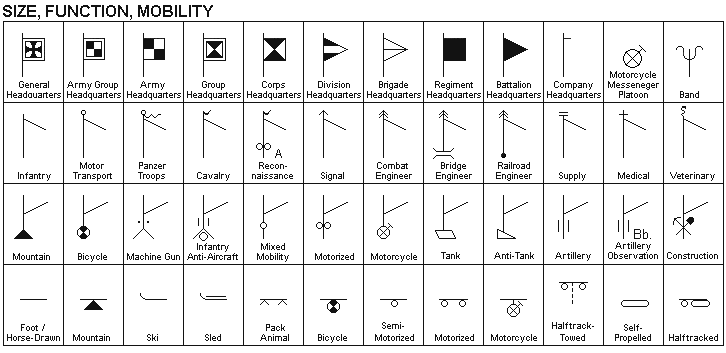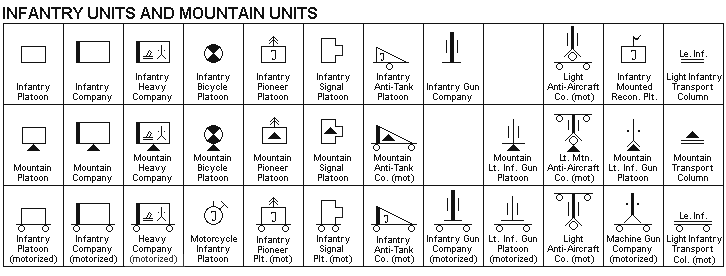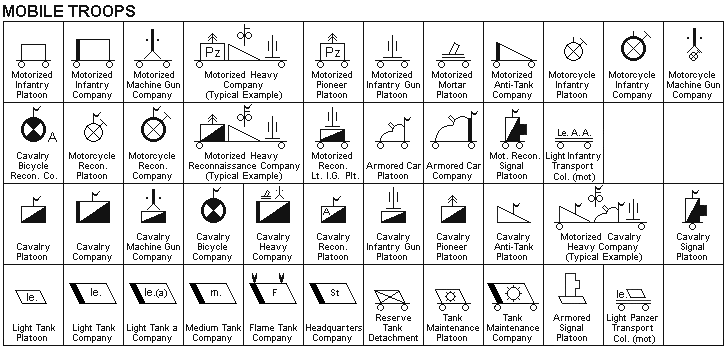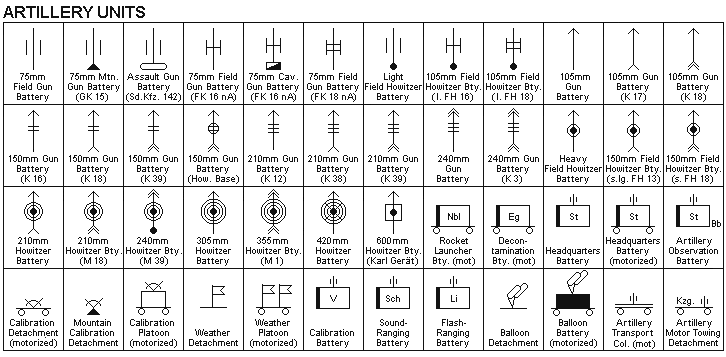WWII German Military Map Symbols
German tactical plotting symbols used in WWII were the lineal descendants of those used by the IGS during WWI. The system in use in 1939 had become so baroque in its detail and special usage that a radically simplified one was introduced in November 1942 and this was further simplified in January of 1943. Basically, the symbol set had four main elements, each of which described a specific feature of the unit/organization represented thereby. The four divisions were: Echelon:Heer, Korps, Division, Regiment, Abteilung, Kompanie Branch:Recon, artillery, engineers, transport, signal, etc. Weapon:Tank, Armoured Car, Infantry Gun, Howitzer, etc. Transport:None, Animal, semi-motor, motor, semi-tracked, tracked Up until 1944, a special staff cornet was superimposed upon the echelon indicator for all units assigned to Panzer formations. This was deleted and the rhomboid tank weapon symbol replaced it regardless of whether or not the unit or organization actually had tanks assigned to it. Infantry units and those support units that did not have weapons or branch symbols assigned to them used the rectangle. This is what in current NATO STANAG parlance is the UNIT symbol. Tank units used a rhomboid symbol. This is a box-like figure which has the two short sides inclined at approximately a 60-degree angle to the horizontal lines. If you can picture a four-stroke line schematic diagram of a WWI American tank you get the idea. Imagine if you had a 1941 recon Abteilung assigned to a Panzer Division and equipped with Mk II tanks. The symbol for this would start with the rhomboid weapons symbol. About 1/6 of the way in from the left end of the topmost line you would have a staff drawn vertically to a convenient height, normally equal to the height of the basic symbol itself. On this staff facing right would be a triangular solid black flag. Surmounting the staff would be a small open circle and a wavy line extending from the staff to the right and originating just below the circle and immediately above the topmost portion of the triangle pennant. This is the Pz cornet. As the rhomboid tank symbol implied fully tracked capability, the open elongated oval indicating this would not be placed beneath the tank symbol. Because this was a recon company, on the staff beneath the pennant but above the unit symbol there would be a small crescent line originating at the staff and extending to the right with the concave side pointing up. An infantry regiment from an infantry division would have a simple rectangle. The staff would have a triangular pennant with the field pointing to the right. The pennant would be black with a broad white stripe extending horizontally from the fly to the point of the field, dividing the field into three horizontal bands of equal thickness (B-W-B) when measured at the staff. The division would use the same basic symbol as its parent but would replace the pennant with a square solid black flag. In both cases, the rectangular unit symbol would be empty. In fact, in 1942 the German unit symbol for supply or logistics formations was the crossed bars that we consider to be the traditional infantry symbol today. If a unit at or below the Abteilung level was predominantly equipped with a single weapon then the symbol for that weapon would be placed inside the otherwise empty unit box. During the course of WWII, there was considerable carry forward of the original symbol set used during the beginning of the war. The various versions suffered much butchery in actual use due to the declining fortunes of the German army from 1943 on which resulted in abbreviated training. Consequently, when viewing original source documents you may often see anachronisms or just plain errors in usage according to the time period and the symbol set that, in theory, was supposed to be in use. The following is a brief visual description of some of the basic elements of the German tactical plotting symbol set.
The German WWII symbol set is overwrought and even in its later, more simple manifestations had a large variety of basic shapes to master in order to read situation maps correctly. The late 70’s STANAG symbol set was probably the most useful set devised for map and pencil use and it or its immediate predecessors form the basis of the symbol set used in most wargames about modern and contemporary conflicts. The supplanting of the paper map and grease pencil with portable tactical computers and GPS processors, coupled with the increased need for data content suitable for targeting and threat analysis, has placed all of these symbol sets on the dust heap of history so far as actual employment by military forces in future wars. The modern warfighting symbol set has more in common with the display of an ATC console in a major airport than the simple line diagrams used to outline battlefield dispositions for the past 200 years or so. |








